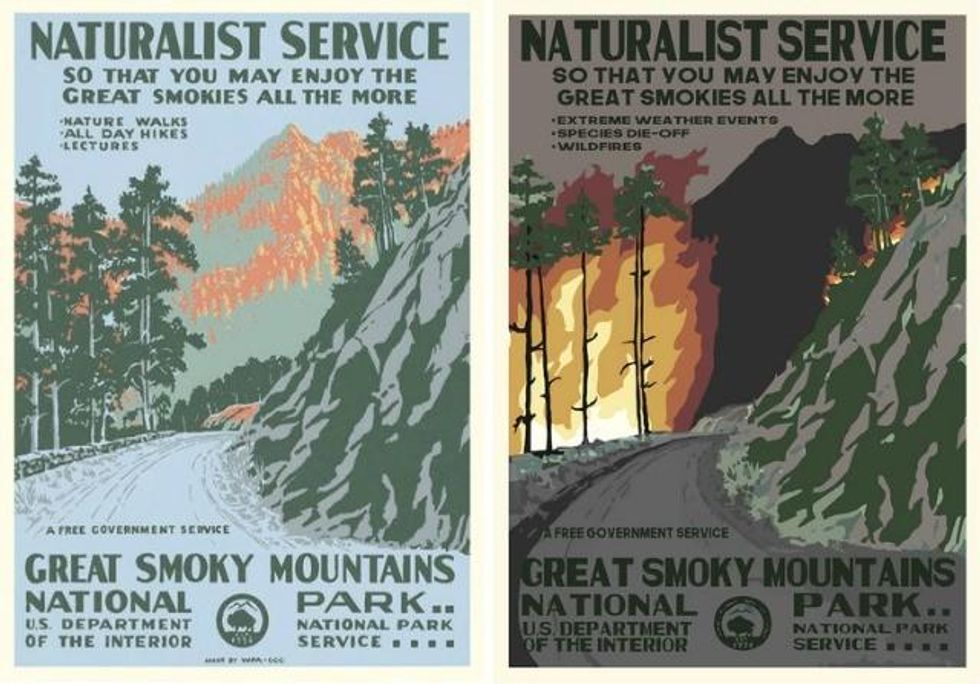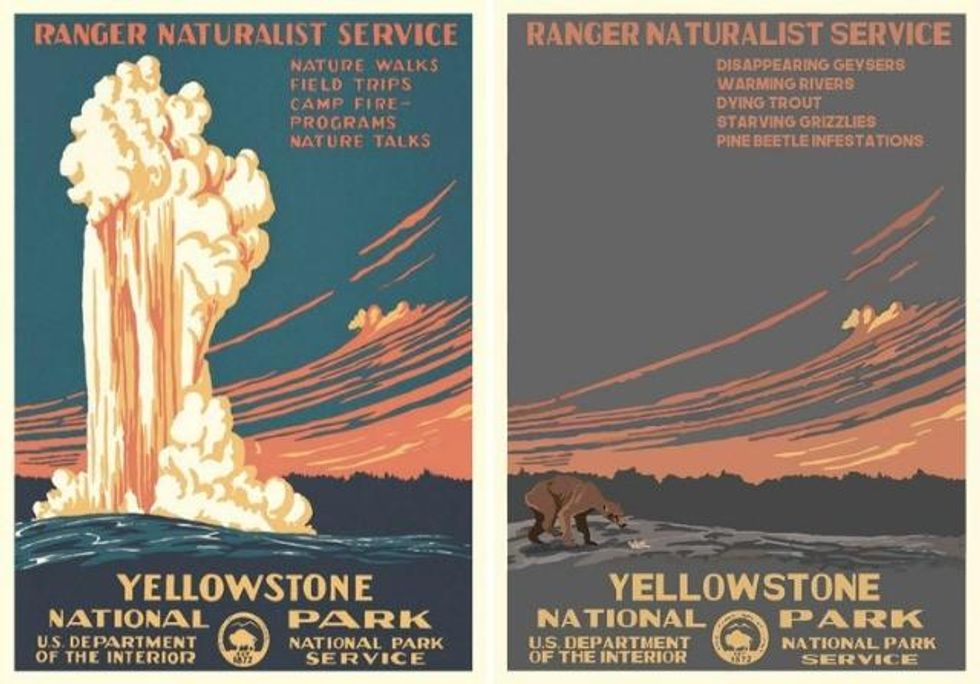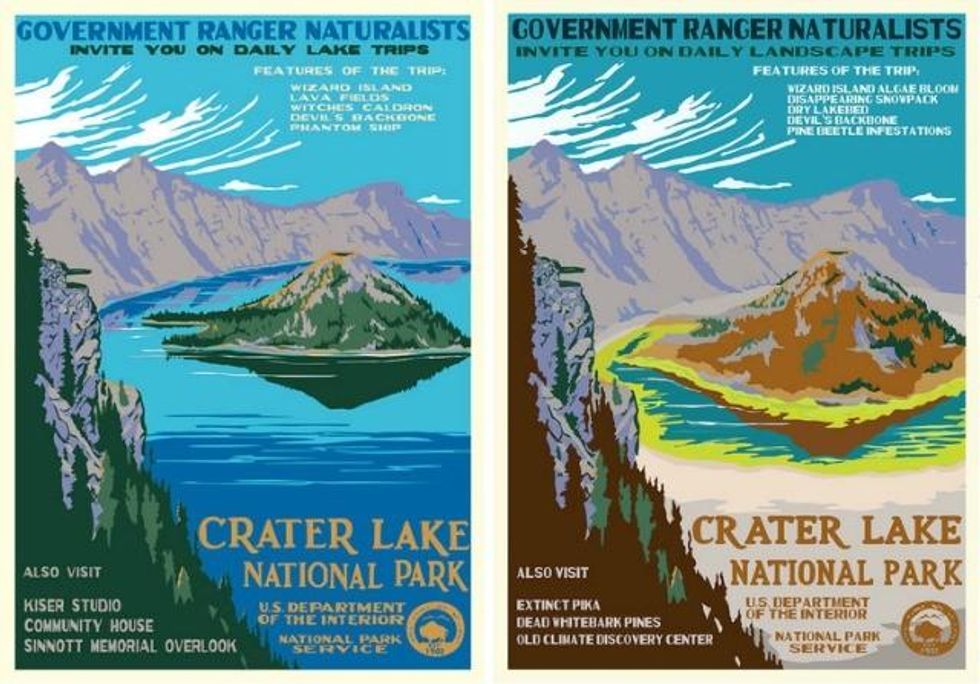
The original Yellowstone poster and the re-imagined one for year 2050. (Left: U.S. Department of the Interior; Right: Hannah Rothstein)
To donate by check, phone, or other method, see our More Ways to Give page.

The original Yellowstone poster and the re-imagined one for year 2050. (Left: U.S. Department of the Interior; Right: Hannah Rothstein)
In a project meant to galvanize people to take action on climate, the Berkeley, California-based artist Hannah Rothstein has redesigned iconic National Parks posters for the year 2050 to showcase the devastation to come if climate change goes unchecked.
"We have the ability to outsmart the issues highlighted in National Parks 2050, but we need to act now."
--Hannah Rothstein, artist
While the Trump administration is rolling back climate policies and reinvigorating the fossil fuel industry, Rothstein calls on viewers to push back with her series National Parks 2050, depicting the terrifying ramifications of such government actions.
The classic posters, originally created by artists working for the Works Progress Administration from 1938 to 1941, have been re-imagined so that instead of blue lakes, towering forests, craggy snow-peaked mountains, and tropical lagoons, the posters showcase horrible algae blooms, dead redwoods, snow-free mountain peaks, and rising seas.

"I think a lot of people recognize the posters and that was key to the success [of this project], to have something familiar to people," Rothstein told Climate Central. "They could be familiar, but then have to look twice to figure out what was different."
With this project, Rothstein seeks to make the climate crisis more visceral to viewers. As VICE's Beckett Mufson writes, "Once you've seen an emaciated Smokey the Bear plodding through a barren landscape, it's hard not to want to call Congress."

"The changes shown are based on information from the parks' .gov sites, scientific reports, and reputable news articles about climate change," Rothstein told Mufson.
"I was only able to include an abbreviated list of potential changes on each poster," Rothstein added. "The predicted changes are actually much more far-reaching than what's highlighted here. I'd encourage people to read up on the predicted changes and start talking about them. Acknowledgement and dialogue are the first steps towards positive change, and we need to get moving on this!"
"We have the ability to outsmart the issues highlighted in National Parks 2050, but we need to act now," Rothstein observes. "From Franklin to Fuller, America has been made its greatest by embracing ingenuity and innovation. If we dive headfirst into inventing for a brighter future, we can prevent National Parks 2050 from becoming a reality."

All of National Parks 2050 can be viewed on Rothstein's website.
Trump and Musk are on an unconstitutional rampage, aiming for virtually every corner of the federal government. These two right-wing billionaires are targeting nurses, scientists, teachers, daycare providers, judges, veterans, air traffic controllers, and nuclear safety inspectors. No one is safe. The food stamps program, Social Security, Medicare, and Medicaid are next. It’s an unprecedented disaster and a five-alarm fire, but there will be a reckoning. The people did not vote for this. The American people do not want this dystopian hellscape that hides behind claims of “efficiency.” Still, in reality, it is all a giveaway to corporate interests and the libertarian dreams of far-right oligarchs like Musk. Common Dreams is playing a vital role by reporting day and night on this orgy of corruption and greed, as well as what everyday people can do to organize and fight back. As a people-powered nonprofit news outlet, we cover issues the corporate media never will, but we can only continue with our readers’ support. |
In a project meant to galvanize people to take action on climate, the Berkeley, California-based artist Hannah Rothstein has redesigned iconic National Parks posters for the year 2050 to showcase the devastation to come if climate change goes unchecked.
"We have the ability to outsmart the issues highlighted in National Parks 2050, but we need to act now."
--Hannah Rothstein, artist
While the Trump administration is rolling back climate policies and reinvigorating the fossil fuel industry, Rothstein calls on viewers to push back with her series National Parks 2050, depicting the terrifying ramifications of such government actions.
The classic posters, originally created by artists working for the Works Progress Administration from 1938 to 1941, have been re-imagined so that instead of blue lakes, towering forests, craggy snow-peaked mountains, and tropical lagoons, the posters showcase horrible algae blooms, dead redwoods, snow-free mountain peaks, and rising seas.

"I think a lot of people recognize the posters and that was key to the success [of this project], to have something familiar to people," Rothstein told Climate Central. "They could be familiar, but then have to look twice to figure out what was different."
With this project, Rothstein seeks to make the climate crisis more visceral to viewers. As VICE's Beckett Mufson writes, "Once you've seen an emaciated Smokey the Bear plodding through a barren landscape, it's hard not to want to call Congress."

"The changes shown are based on information from the parks' .gov sites, scientific reports, and reputable news articles about climate change," Rothstein told Mufson.
"I was only able to include an abbreviated list of potential changes on each poster," Rothstein added. "The predicted changes are actually much more far-reaching than what's highlighted here. I'd encourage people to read up on the predicted changes and start talking about them. Acknowledgement and dialogue are the first steps towards positive change, and we need to get moving on this!"
"We have the ability to outsmart the issues highlighted in National Parks 2050, but we need to act now," Rothstein observes. "From Franklin to Fuller, America has been made its greatest by embracing ingenuity and innovation. If we dive headfirst into inventing for a brighter future, we can prevent National Parks 2050 from becoming a reality."

All of National Parks 2050 can be viewed on Rothstein's website.
In a project meant to galvanize people to take action on climate, the Berkeley, California-based artist Hannah Rothstein has redesigned iconic National Parks posters for the year 2050 to showcase the devastation to come if climate change goes unchecked.
"We have the ability to outsmart the issues highlighted in National Parks 2050, but we need to act now."
--Hannah Rothstein, artist
While the Trump administration is rolling back climate policies and reinvigorating the fossil fuel industry, Rothstein calls on viewers to push back with her series National Parks 2050, depicting the terrifying ramifications of such government actions.
The classic posters, originally created by artists working for the Works Progress Administration from 1938 to 1941, have been re-imagined so that instead of blue lakes, towering forests, craggy snow-peaked mountains, and tropical lagoons, the posters showcase horrible algae blooms, dead redwoods, snow-free mountain peaks, and rising seas.

"I think a lot of people recognize the posters and that was key to the success [of this project], to have something familiar to people," Rothstein told Climate Central. "They could be familiar, but then have to look twice to figure out what was different."
With this project, Rothstein seeks to make the climate crisis more visceral to viewers. As VICE's Beckett Mufson writes, "Once you've seen an emaciated Smokey the Bear plodding through a barren landscape, it's hard not to want to call Congress."

"The changes shown are based on information from the parks' .gov sites, scientific reports, and reputable news articles about climate change," Rothstein told Mufson.
"I was only able to include an abbreviated list of potential changes on each poster," Rothstein added. "The predicted changes are actually much more far-reaching than what's highlighted here. I'd encourage people to read up on the predicted changes and start talking about them. Acknowledgement and dialogue are the first steps towards positive change, and we need to get moving on this!"
"We have the ability to outsmart the issues highlighted in National Parks 2050, but we need to act now," Rothstein observes. "From Franklin to Fuller, America has been made its greatest by embracing ingenuity and innovation. If we dive headfirst into inventing for a brighter future, we can prevent National Parks 2050 from becoming a reality."

All of National Parks 2050 can be viewed on Rothstein's website.